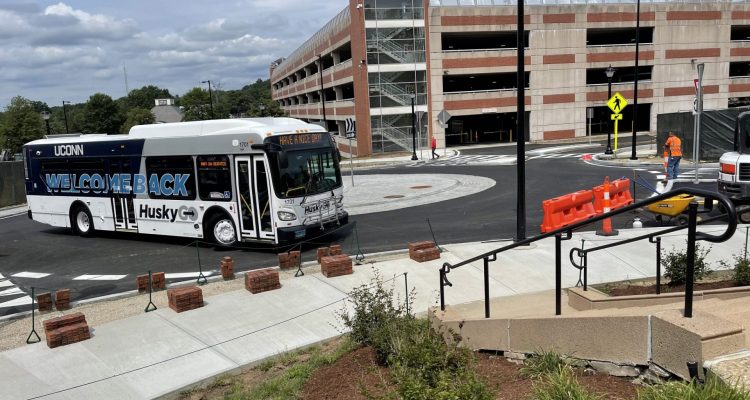By Jonathan Kopeliovich
At night, the campus is peaceful. One may see deer roaming as they walk along the Great Lawn. The steam on Gilbert Rd mingles playfully with the frosty breath of students. The few stars that are visible reflect brightly off of Mirror Lake’s quiet surface. All of a sudden, a scream rings out and penetrates the eardrums of insomniacs on their last legs.
“CAUTION: BUS IS TURNING,” screams a mysterious female voice into the night sky. While these words are well known to UConn inhabitants, the origins are a little more technical.
The development of the voice that is heard on the bus today started with a company called Protran Technologies. The company specializes in creating secondary warning systems for rail and bus transit systems, their website states. An example of one of their secondary warning systems is their Collision Avoidance System for rail workers. The device, which is placed on a train and rail workers, emits a loud alarm when a train breaches a certain proximity. This gives the rail workers enough time to safely move away from the tracks and avoid being demolished by the mechanical beast.
“One of our public transits that used our rail safety system came to us in 2009, asking us to develop a bus pedestrian pedestrian safety system, a way to warn the pedestrians and cyclists around in and around the bus that in the bus really near or around the bus that the bus is there that it’s turning. The highest number of incidents with pedestrians around buses in highly congested public areas are when the bus is turning,” stated Jaime Maguire, the Program Director of the Safety Solutions Division at Protran Technology.
Their first bus transit customer was Greater Cleveland Regional Transportation Authority, according to Maguire. Protran would then develop the SafeTurn alert system for buses; at the time, the device was nothing like it was now. There were no user-configurable settings, the message couldn’t be changed, and the volume was the same at all times, Maguire said.
“I don’t know who it is. It was one of our engineers, somebody that first engineer that developed it had someone record it and layered it there so yeah, we just called her the Talking SafeTurn Alert Girl. But um, so now though, we have our safe turn or 2.0 has multiple messages in multiple languages and we just use basically our employees who are able to do that to record them,” Maguire stated.
The voice has been lost to time as the engineer in question does not work at Protran anymore. In response to a request to interview that engineer, Maguire said that it has been more than ten years since the SafeTurn device was developed. There would be unwarranted difficulties in contacting them.
Since 2009, the SafeTurn Alert system has received several upgrades. The slight possibility of Luis Diaz, also known as the “Soop Doop Guy” yelling about a bus turning would bring smiles to many. The system can adjust volume based on outside ambient noise. If the bus is going at or above a certain speed, the voice will turn off; similarly, the system is deactivated when the bus doors are open. SafeTurn also possesses a GPS with geofencing capabilities. This means that the user can set up certain areas on campus in which the alerts may be quieter. The system also comes with LEDs attached to the front of the bus which serves as a visual warning to pedestrians.
Ultimately, the existence of SafeTurn Alert is warranted. A study published in the peer-reviewed Journal of Safety Research by Stravinos and others unsurprisingly concluded that cell phone use distracted college students while walking on the street. To this effect, Maguire stated that the responsibility of awareness falls on the pedestrian, but is shared by the driver. An internal speaker attached on the inside by the driver gives an occasional alert for them to look out for pedestrians. The system also has a blind spot awareness feature where an alert will sound if an object or person is detected in the bus’s blind spot.
“You know, it’s a bus, you should be able to see it. I mean, we’re happy to give you that extra warning. But, you know, like I said, the bus drivers are really busy, they can’t really see everything that’s going on and a little person under the, you know, under the big bus, you can’t literally can’t see them. Sometimes the buses have a lot of blind spots. And you know, it’s real, it’s a real safety issue. And I don’t think people realize that they think, you know, oh, I’m here, you know, they can see me and they can’t. So you really just look both ways. Like, like your mother taught you before you cross the street” Maguire stated.


